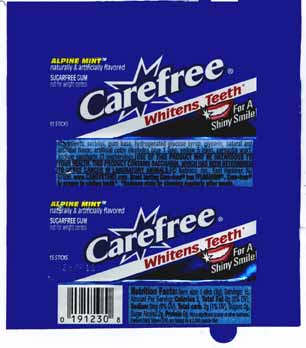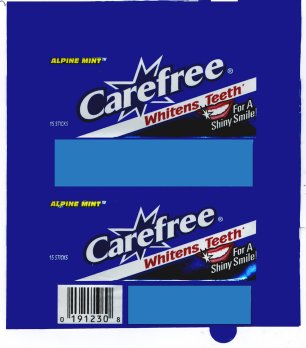Last week we had two speakers on campus that both addressed academic dishonesty and technology’s role in cheating. Most of the examples were what I would consider low-tech because they involved nothing more than a scanner, Photoshop and a color printer.
Take a look at this picture.

Now compare the original with the one below that has been altered to clear the nutrition facts.

Using any photo editor a “cheat sheet” can be easily created on a pack of gum. All the student has to do is sneak the gum into the test. Most teachers would not think to check something as innocent as a pack of gum.
I found both of the above images on the web by search for “carefree gum cheating” on Google. The page I found had all the instructions. If you prefer to learn you cheating via multimedia, here is a YouTube video that does something similar using a Coke bottle.
http://www.youtube.com/watch?v=NRgM9-n7K5E
If you are giving an exam, you can avoid problems created by these cheating techniques if you ask your questions in the right way. Questions that are more conceptual in nature aren’t as easily answered by a short list of definitions, but having a list of formulas can give someone a real advantage on most math or physics tests.
I do not a big concern for cheats like these. All my exams are open book with a time limit. I am looking out for more sophisticated chicanery. All my students have USB drives. One student could easily copy a file onto one of these devices and pass it to another student who could copy it into a new project.
One or two times each year I have a student turn in the wrong file during a test. Normally the file is the “starting document” with the instructions for the final project. The student saves the initial file to a USB drive, works on the test and then saves a new file to the USB drive. When it comes time to submit the completed work, the initial file is uploaded. Of course I don’t know it’s the wrong file until I grade the projects. By that time, the student has had time to tweak the final project, if the intent was to cheat.
My solution to this problem is simple. If I give a student a test and the student gives that test back to me without making any modifications, it is the same as turning in test a without adding any answers. It’s a zero.
I am waiting for a student to take cheating to the highest level. This would involve some sort of remote control of the lab computer. During the test, the student could permit an outside “paid expert” to take control of the lab computer and complete the test. All the student would have to do is “look” like he is typing and moving the mouse.
Fortunately the jump from Coke bottles to expert remote control isn’t easy, but some day it will be.

Pingback: Techno-Cheating
Pingback: Techno-Cheating
Pingback: technology » Blog Archive » Techno-Cheating